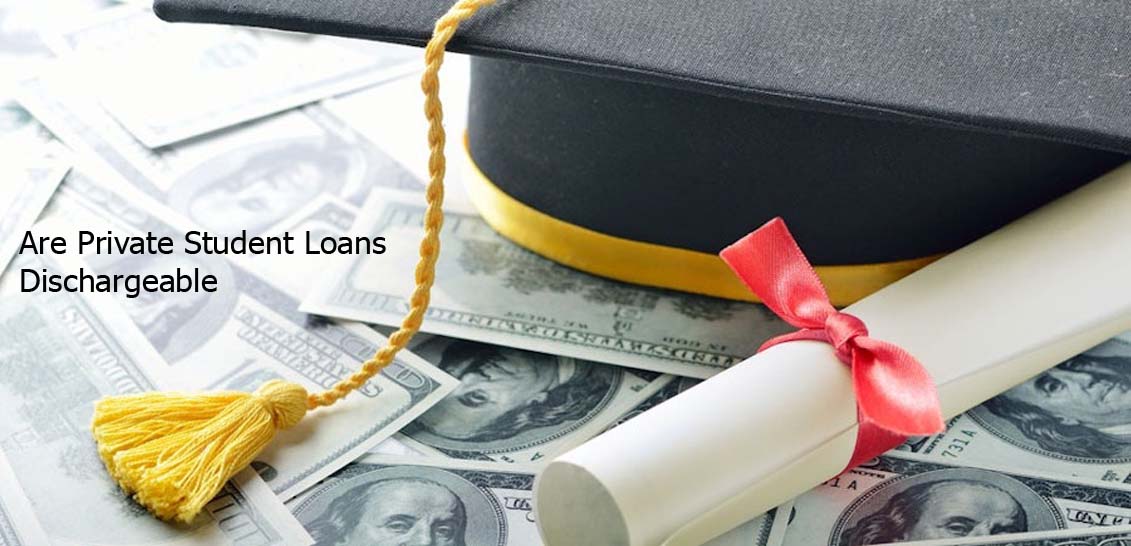Are private student loans dischargeable? Filing for bankruptcy can help you to get rid of private student loans, no doubt, but you should also know that they are very much harder to get rid of than any other type of debt.

Are Private Student Loans Dischargeable
To have your private student loans discharged you will need to prove on your end that your loan was a qualified education loan and also that paying off the loan would cause you undue hardship. You have to prove undue hardship as part of an adversary proceeding. This is however an additional proceeding on top of your bankruptcy case. For private student loans, these very proceedings are run a lot like a civil lawsuit. In order to successfully file bankruptcy on private student loans, many people involved usually chose to hire a bankruptcy attorney.
Federal student loan borrowers typically have more student loan forgiveness options in contrast to private student loan borrowers. For instance, federal student loan borrowers can easily take advantage of income-based repayment plans, forbearance, or even deferment to lower their monthly payments or get to temporarily pause payments.
Private student loan borrowers on many occasions have options such as federal student loan borrowers. This tends to lead some people to wonder if bankruptcy is the solution to dealing with an overwhelming student loan debt.
In most certain cases, your student loan debt can be discharged as part of a Chapter 7 or Chapter 13 bankruptcy case, but you must however take the additional step that is needed to file an adversarial proceeding after you get to file your bankruptcy case. After that, you will need to prove that paying off the debt in question would cause you undue hardship which is at most times determined by using the Brunner Test.
What Is the Brunner Test and How Do You Pass It
In many federal courts in the US, you will need to pass the Brunner Test in order to discharge a student loan. The Brunner Test originally was created by the court in a case known as Brunner v. New York State Higher Education Services Corp. The Brunner Test as you should know is what determines whether or not repaying your loans is causing undue hardship on your end. In other words, this very test sets the terms for the undue hardship standard. And if you can’t meet up to this standard, you will not have your loans discharged.
All states as well as territories in the U.S. make use of the Brunner Test in their bankruptcy courts, except for states such as Maine, Massachusetts, New Hampshire, Rhode Island, Puerto Rico, Minnesota, Iowa, North Dakota, South Dakota, Nebraska, Missouri, and Arkansas.
And as you should know, there are three parts to the Brunner test to help the court determine if an undue hardship actually exists.
The First Part – Minimal Standard Of Living
In order to pass the first part of the Brunner Test you must prove that you have extenuating circumstances that create a hardship. In other words, you cannot pay the student loan all the while still maintaining a minimum standard of living. Each court on its own can decide for itself on how to define a minimum standard of living.
The Second Part – Hardship Persists For a Significant Part of the Repayment Period
If you get to pass the first part of the test, then you have to prove that your hardship in question will continue for most of the repayment term of the loan. And as you might imagine, it can be quite difficult to predict just how long a bad financial situation will persist. And to further complicate matters, courts interpret hardship quite differently. This however may be easier to prove in the event that you are over age 65 or you have a permanent disability.
You should know that your local Bankruptcy Court will have its very own interpretation of what it terms a “substantial portion” of the repayment period.
The Third Part – Good Faith Effort in Repaying the Student Loan
The last hurdle in the Brunner Test is showing that you have made a “good faith effort” in repaying your educational loans. And just like the second part of the test, bankruptcy courts will interpret this differently and some are stricter than others, just so you know.
As kind of a general rule, most courts will want to see that you have at least made an effort to find employment, maximize your income, and even minimize your expenses. They would also want to see that you have made an effort to make at least one student loan payment or even made an attempt in negotiating a repayment plan with the lender.
MORE RELATED POSTS



